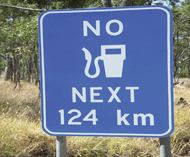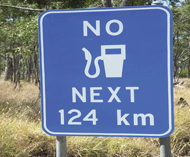
Horror story!
You’ll never ‘just fill ’er up’ again after you’ve read this report by Stuart Woodbury
Many riders are not fully informed about the main thing that makes their bikes go – fuel.
Years ago when I was racing two-stroke go-karts, competitors were subjected to regular fuel testing at national and state titles, especially if you got a place at the pointy end. In the course of all this I got to understand the data on different fuels, fuel condition and even how temperature can affect an engine’s performance. But I wanted to find out more about the liquid gold we pour into our motorcycles, so I spoke with Dale Brown-Kenyon, fuel specialist with BP.
The fuel we use in our vehicles can take between 9-18 weeks to get to our local bowsers.
It may be that you tell everyone, “my bike runs best on Caltex” and another one of your mates might say, “oh, but mine runs best on BP”. Not really. It all really depends on how fresh the fuel is. So if you go to a service station that has a high turnover, you have more of a chance of getting better fuel to look after your engine.
There are only seven refineries in Australia producing all of the nation’s unleaded fuel; the BP and Caltex refineries in Queensland, Shell and Caltex refineries in NSW, Mobil and Shell in Victoria and BP in West Australia.
You might think that if you filled up in a Mobil service station in Queensland you would get fuel from the Mobil refinery in Victoria. Nope. What you will get is fuel refined in either the BP or Caltex units Queensland but the refinery will add specific contents as per Mobil’s requirements.
The same applies with other brands in the other States.
It is recommended that most bikes run premium unleaded fuel of 95 or 98 octane. It’s pretty hard to go wrong with these but I suggest you refer to your owner’s manual or the manufacturer about which fuel is best. However, most people just fill up with a particular fuel because one of their mates told them it is the best fuel, when I doubt whether they fully understand the fuel themselves.
In terms of particular brands – BP, Shell, Mobil or Caltex – it doesn’t really matter, each will say their fuel is better. I would suggest you stay with the major brands and try to stay clear of the independent service stations because you can never be guaranteed of the quality. (Remember the Sydney independent servo that was watering down its fuel?)
In saying this, we recently had reports of some bikes playing up when using Shell V-Power that resulted in a yellow gel/sludge type material building up in the tank and then spreading through the fuel system. The Bear found this out himself when he had to clean out the tank and carburettors on his Bonneville after a single fill with V-Power.
To find out more about this, I spoke with Paul Smallacombe from Shell’s technical advice department, who said he had not heard of such a problem using the V-Power on its own. The only time he had seen the type of material I described was when someone had used a fuel additive such as an octane booster, which reacts badly with the high solvency of the 98 octane fuels regardless of the brand.
There was nothing like that in our Bonneville.
Paul suggested that the only other thing it might be was that the high solvency V-Power had reacted with plastic or fibreglass fuel tanks, or a material used to line the inside of a metal tank.
On the Shell website it states, “Although Shell V-Power is compatible with most bikes, there may be a requirement to make slight adjustments to the engine such as changing spark plugs and reducing the size of carburettor jets, or a combination of both.”
BP, Caltex and Mobil don’t say your bike will need such adjustment, so using Shell might well be something to be wary of.
From July 1, 2011, 91 octane or “standard” unleaded (as most people know it) will be phased out in NSW. The only other relatively low octane unleaded fuel to be sold from then on will be that containing up to 10 per cent ethanol (called E10).
According to the Federal Chamber of Automotive Industries (FCAI) list of vehicles that are suitable to use E10, BMW and Harley-Davidson motorcycles post-1986 can use it, so can all Buell, Polaris and Victory motorcycles.
All Honda, Kawasaki, Suzuki, Piaggio and Yamaha motorcycles are NOT suitable for E10 fuel. So, if you live in NSW, or will be travelling through NSW, beware of what pump you pick up. Many service stations have already changed over and are pretty well marked but still look carefully and ask the service station attendant if you’re unsure.
E10 fuel contains more oxygen than standard unleaded, which makes the air/fuel ratio leaner, therefore the oxygen sensor will compensate for this by richening the fuel mixture causing fuel consumption to go up by about 3 per cent.
Another bad thing with ethanol is that it absorbs water. If too much water is present, the ethanol and fuel can separate which is called “phase separation”. Pure ethanol on its own will cause damage to the fuel system, which is not a good thing. Ethanol can also damage fibreglass fuel tanks, so do not use E10 if you have one.
The actual effectiveness of current grade of fuels available can vary depending on how “fresh” they are. Standard unleaded can range from 91-93 octane, 95 premium can vary from 95-96 octane and the 98 premium can vary from 98-100 octane. E10 is 94 octane. If your motorcycle is suitably tuned, you can buy Racing 100 from authorised outlets, which has a variance in octane from 105-115. The 95 octane fuel is the standard fuel used in Europe and the USA. Expect this to be a fuel of the future.
If your motorcycle has a high compression ratio, as most bikes do these days, you may be interested to know that the higher the octane the fuel, the better your engine will perform. The highest compression ratio the fuels now available (excluding Racing 100) can handle is 10.5:1.
Interestingly, though, the fact that bikes run at high RPM and have small cylinders with short flame paths, reduces the octane requirement. This said, BP’s Dale Brown-Kenyon supplied information showing that premium unleaded fuels have a lower corresponding air/fuel ratio. This means you can put more fuel in for the same engine capacity, giving a cooler running engine and producing more power. Sounds good to me!
Storage of fuel is one variable that can affect the performance of your bike. If the fuel is older than 4-8 weeks and hasn’t had any fresh petrol added, you may well experience reduced performance because the fuel loses volatility and octane rating. You will also experience difficulty starting because you will have lost some of the “light ends” of the fuel, which is what starts the engine. Possibly spark plug fouling will have occurred as well because the density of the fuel will have increased and probably will have caused flooding because of the richer air/fuel mixture.
You know when you open the fuel container for the mower and it makes that “psst” sound? That’s the fuel losing its “light end” properties, or volatility and it’s why the mower is so hard to start after the fuel has been around for a while.
Having seen on paper how the “psst” factor, condition and temperature can affect overall performance, I suggest that if you have to store fuel, keep it in as cool a place as possible in a well ventilated area and as much as possible try to avoid opening the container. I used to store my fuel in half thawed out ice and I would achieve maximum power every time, according to the fuel testing graphs.
If fuel is left unused for a length of time it can turn into a gummy type liquid that blocks fuel lines and, depending on how bad it becomes, will result in your bike not starting and might even require that the fuel system be cleaned or replaced.
If you are like some people nowadays and are concerned with “green” issues, it may interest you to know that the “standard” unleaded and E10 fuels emit heavily and have the worst carbon footprint. In terms of exhaust, the standard and E10 shoot out 150ppm (parts per million) of sulphur.
Now if you compare this with the premium fuels, in which impurities are much reduced, they will emit only 50ppm sulphur. This is the green road you need to take to help the environment. Emissions of carbon monoxide, hydrocarbons and nitrogen oxides are also far reduced with the premium fuels.
So use premium fuels (except maybe Shell V-Power). Not only do they emit a cleaner exhaust but are much better for your engine because they have special cleaning detergents. As you know, a cleaner fuel system results in better performance and better fuel consumption.
So there you have it, fuels ain’t fuels, as the saying goes, and be mindful of what you are actually putting in your bike next time you fill up because putting the wrong fuel can have dire consequences. It will cost you power and efficiency.

